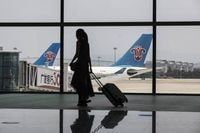After a five-year freeze that symbolized deep diplomatic rifts, India and China are poised to reconnect their skies, resuming direct flights between major cities later this month. The move comes as both nations, home to over 2.8 billion people combined, signal a cautious but notable thaw in relations after years of tension and near-silence following a deadly military clash along their disputed Himalayan border in 2020.
India’s largest carrier, IndiGo, announced on October 2, 2025, that it will restart daily, non-stop flights between Kolkata and Guangzhou beginning October 26. The flights, operated on Airbus A320neo aircraft, will mark the first direct air link between the neighbors since the abrupt halt in 2020, when both the COVID-19 pandemic and military standoffs upended cross-border movement. Subject to regulatory approvals, IndiGo also plans to launch direct flights between Delhi and Guangzhou, signaling even broader connectivity on the horizon.
According to the Economic Times, Chinese Embassy spokesperson Yu Jing called the resumption of direct flights “significant for enhancing cross-border exchanges and cooperation.” In a statement on X, Yu Jing wrote, “As the world’s two most populous neighbors, China and India together account for over 2.8 billion people. The resumption of direct flights between the Chinese mainland and India will further facilitate cross-border travel, exchanges, and cooperation.” She further emphasized that China has been in close communication with India to promote the early resumption of direct flights.
The diplomatic machinery behind this breakthrough has been moving steadily throughout 2025. In August, Chinese Foreign Minister Wang Yi visited India, meeting with External Affairs Minister S. Jaishankar. The two agreed to expedite the resumption of direct flights and finalize an updated Air Services Agreement, also discussing visa facilitation for tourists, business travelers, media, and other visitors. The following month, Indian Prime Minister Narendra Modi traveled to China for the first time in seven years to attend a Shanghai Cooperation Organization (SCO) summit, where he met with Chinese President Xi Jinping. Both leaders agreed that India and China should be “development partners, not rivals,” and discussed ways to strengthen trade ties amid global economic uncertainty, according to Reuters.
The Indian Ministry of External Affairs (MEA) has underlined the importance of this development as reflecting a growing trend toward normalization in bilateral ties. MEA spokesperson Randhir Jaiswal stated on October 3, 2025, “Yesterday we had issued a press release and thereafter I understand that commercial activity in this regard has started. This is, of course, in line with the growing trend towards normalisation in the relationship between India and China.” The MEA also noted that direct air services connecting designated points in both countries would resume in line with the winter season schedule, subject to commercial decisions by carriers and fulfillment of operational criteria.
The symbolism of these flights cannot be overstated. The last five years saw relations between the two Asian giants reach their lowest point in decades. In May 2020, a violent clash near the Galwan river valley resulted in the deaths of 20 Indian and 4 Chinese soldiers, triggering a military standoff and freezing high-level engagement. Direct flights, which had already been suspended due to the pandemic, became a casualty of the broader diplomatic breakdown.
Guangzhou Baiyun International Airport confirmed on October 3, 2025, that direct flights would resume later this month, ending the more than five-year hiatus. In a statement, the state-backed airport said, “In the future, Guangzhou Baiyun Airport will also actively promote airlines to open direct routes such as Guangzhou and Delhi.” This announcement was the first public comment by Chinese authorities acknowledging the move, as reported by Travel Radar.
For India, the resumption of flights is both a diplomatic and economic milestone. China remains India’s largest bilateral trade partner, with annual trade topping $100 billion, yet the trade deficit with China has ballooned to nearly $99.2 billion. During his September visit, Prime Minister Modi raised concerns about this deficit with President Xi, while also emphasizing the importance of maintaining peace and stability along their disputed border. “Stable, predictable, and constructive India-China ties would contribute significantly to regional and global peace and prosperity,” Modi stressed during his meetings, according to The Hindu.
IndiGo’s CEO, Pieter Elbers, expressed enthusiasm about the new route, stating, “We are delighted to announce the resumption of daily, non-stop flights between India and mainland China. We are proud to be amongst the first to resume direct connectivity to China from two points in India. This will once again allow seamless movement of people, goods, and ideas, while also strengthening bilateral ties between the two of the world’s most populous countries and fast-growing economies. With this very important step, we are looking at introducing more direct flights into China. As we take steady strides towards becoming a global aviation player, this is a significant move to strengthen our international network.”
IndiGo operated flights between India and China before the pandemic and, according to the airline, has many of the necessary arrangements and processes already in place. “The past experience and familiarity with local partners will enable IndiGo to resume these flights swiftly,” the company noted in its statement. Tickets for the resumed flights went on sale October 3, with bookings available through IndiGo’s official website and mobile app.
On the Chinese side, authorities have signaled not just a willingness but an eagerness to restore and expand air links. The revised Air Services Agreement, finalized after months of negotiation, is expected to further facilitate people-to-people contact and contribute to the gradual normalization of bilateral exchanges. Both sides see direct flights as a foundation for broader cooperation, including in tourism, business, and cultural exchange.
Of course, the path to normalization remains delicate. The specter of the 2020 border clash still looms large, and both governments have been careful to frame the resumption of flights as a step-by-step process, dependent on continued diplomatic progress. Still, the reopening of the skies is being hailed as a concrete sign that the world’s two largest countries are ready to move past the bitterness of recent years.
As the first planes take off later this month, many travelers and businesspeople will be watching closely. For them, and for the governments in Beijing and New Delhi, these flights represent more than just a return to pre-pandemic normalcy—they are a symbol of hope that dialogue and cooperation can take wing once again.



